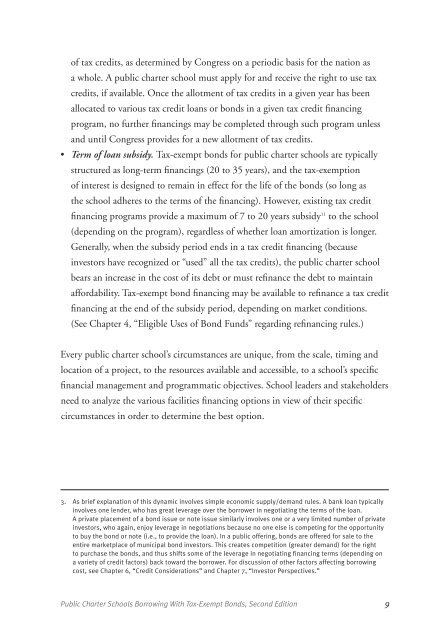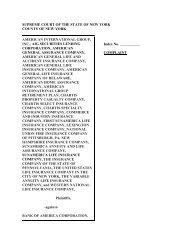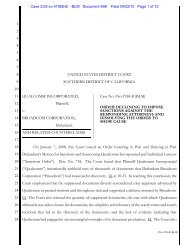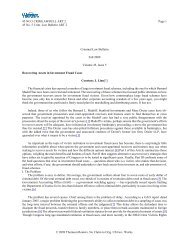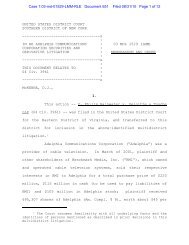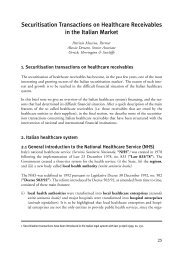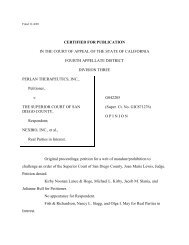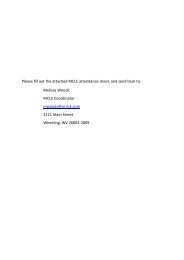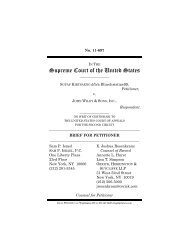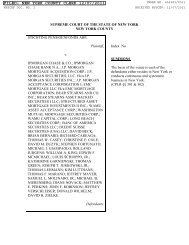Public Charter Schools Borrowing With Tax-Exempt Bonds, Second ...
Public Charter Schools Borrowing With Tax-Exempt Bonds, Second ...
Public Charter Schools Borrowing With Tax-Exempt Bonds, Second ...
You also want an ePaper? Increase the reach of your titles
YUMPU automatically turns print PDFs into web optimized ePapers that Google loves.
of tax credits, as determined by Congress on a periodic basis for the nation as<br />
a whole. A public charter school must apply for and receive the right to use tax<br />
credits, if available. Once the allotment of tax credits in a given year has been<br />
allocated to various tax credit loans or bonds in a given tax credit financing<br />
program, no further financings may be completed through such program unless<br />
and until Congress provides for a new allotment of tax credits.<br />
• Term of loan subsidy. <strong>Tax</strong>-exempt bonds for public charter schools are typically<br />
structured as long-term financings (20 to 35 years), and the tax-exemption<br />
of interest is designed to remain in effect for the life of the bonds (so long as<br />
the school adheres to the terms of the financing). However, existing tax credit<br />
financing programs provide a maximum of 7 to 20 years subsidy 11 to the school<br />
(depending on the program), regardless of whether loan amortization is longer.<br />
Generally, when the subsidy period ends in a tax credit financing (because<br />
investors have recognized or “used” all the tax credits), the public charter school<br />
bears an increase in the cost of its debt or must refinance the debt to maintain<br />
affordability. <strong>Tax</strong>-exempt bond financing may be available to refinance a tax credit<br />
financing at the end of the subsidy period, depending on market conditions.<br />
(See Chapter 4, “Eligible Uses of Bond Funds” regarding refinancing rules.)<br />
Every public charter school’s circumstances are unique, from the scale, timing and<br />
location of a project, to the resources available and accessible, to a school’s specific<br />
financial management and programmatic objectives. School leaders and stakeholders<br />
need to analyze the various facilities financing options in view of their specific<br />
circumstances in order to determine the best option.<br />
3. As brief explanation of this dynamic involves simple economic supply/demand rules. A bank loan typically<br />
involves one lender, who has great leverage over the borrower in negotiating the terms of the loan.<br />
A private placement of a bond issue or note issue similarly involves one or a very limited number of private<br />
investors, who again, enjoy leverage in negotiations because no one else is competing for the opportunity<br />
to buy the bond or note (i.e., to provide the loan). In a public offering, bonds are offered for sale to the<br />
entire marketplace of municipal bond investors. This creates competition (greater demand) for the right<br />
to purchase the bonds, and thus shifts some of the leverage in negotiating financing terms (depending on<br />
a variety of credit factors) back toward the borrower. For discussion of other factors affecting borrowing<br />
cost, see Chapter 6, “Credit Considerations” and Chapter 7, “Investor Perspectives.”<br />
<strong>Public</strong> <strong>Charter</strong> <strong>Schools</strong> <strong>Borrowing</strong> <strong>With</strong> <strong>Tax</strong>-<strong>Exempt</strong> <strong>Bonds</strong>, <strong>Second</strong> Edition 9


